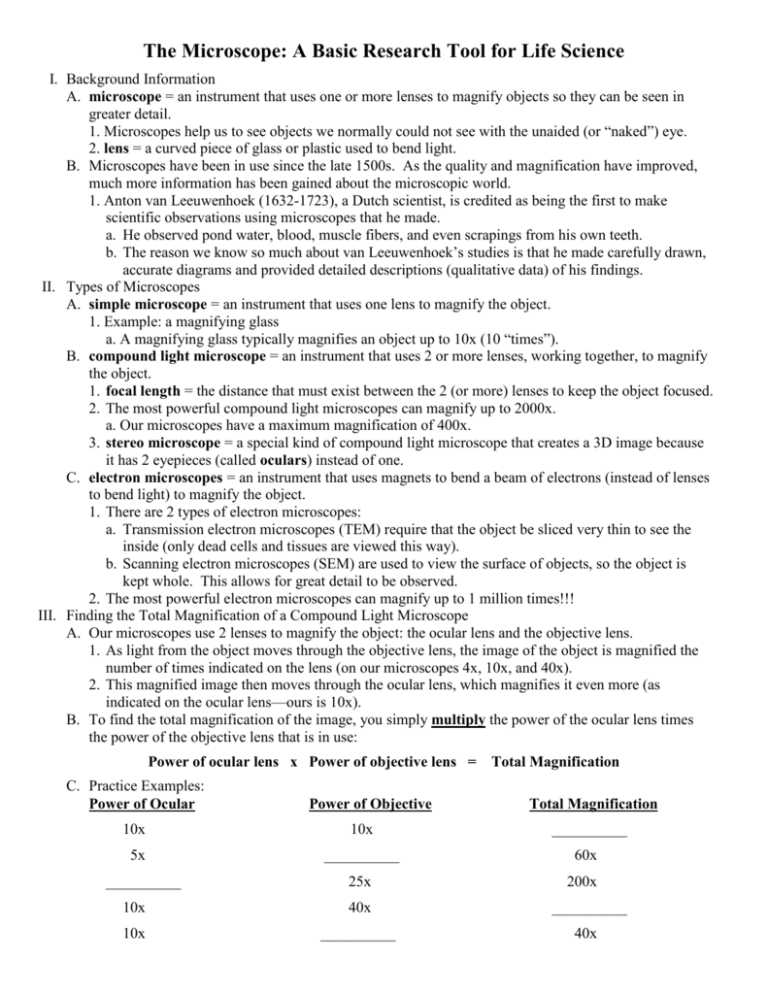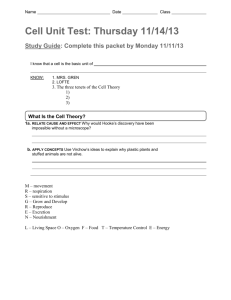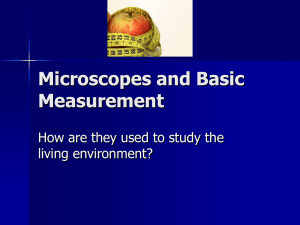Are You suprised ?
advertisement

The Microscope: A Basic Research Tool for Life Science I. Background Information A. microscope = an instrument that uses one or more lenses to magnify objects so they can be seen in greater detail. 1. Microscopes help us to see objects we normally could not see with the unaided (or “naked”) eye. 2. lens = a curved piece of glass or plastic used to bend light. B. Microscopes have been in use since the late 1500s. As the quality and magnification have improved, much more information has been gained about the microscopic world. 1. Anton van Leeuwenhoek (1632-1723), a Dutch scientist, is credited as being the first to make scientific observations using microscopes that he made. a. He observed pond water, blood, muscle fibers, and even scrapings from his own teeth. b. The reason we know so much about van Leeuwenhoek’s studies is that he made carefully drawn, accurate diagrams and provided detailed descriptions (qualitative data) of his findings. II. Types of Microscopes A. simple microscope = an instrument that uses one lens to magnify the object. 1. Example: a magnifying glass a. A magnifying glass typically magnifies an object up to 10x (10 “times”). B. compound light microscope = an instrument that uses 2 or more lenses, working together, to magnify the object. 1. focal length = the distance that must exist between the 2 (or more) lenses to keep the object focused. 2. The most powerful compound light microscopes can magnify up to 2000x. a. Our microscopes have a maximum magnification of 400x. 3. stereo microscope = a special kind of compound light microscope that creates a 3D image because it has 2 eyepieces (called oculars) instead of one. C. electron microscopes = an instrument that uses magnets to bend a beam of electrons (instead of lenses to bend light) to magnify the object. 1. There are 2 types of electron microscopes: a. Transmission electron microscopes (TEM) require that the object be sliced very thin to see the inside (only dead cells and tissues are viewed this way). b. Scanning electron microscopes (SEM) are used to view the surface of objects, so the object is kept whole. This allows for great detail to be observed. 2. The most powerful electron microscopes can magnify up to 1 million times!!! III. Finding the Total Magnification of a Compound Light Microscope A. Our microscopes use 2 lenses to magnify the object: the ocular lens and the objective lens. 1. As light from the object moves through the objective lens, the image of the object is magnified the number of times indicated on the lens (on our microscopes 4x, 10x, and 40x). 2. This magnified image then moves through the ocular lens, which magnifies it even more (as indicated on the ocular lens—ours is 10x). B. To find the total magnification of the image, you simply multiply the power of the ocular lens times the power of the objective lens that is in use: Power of ocular lens x Power of objective lens = C. Practice Examples: Power of Ocular Power of Objective Total Magnification Total Magnification 10x 10x __________ 5x __________ 60x 25x 200x __________ 10x 40x __________ 10x __________ 40x




